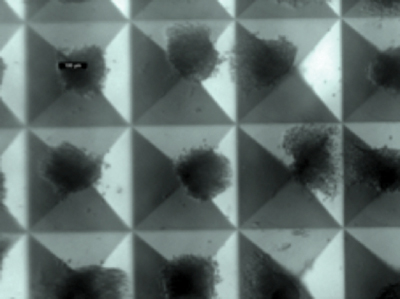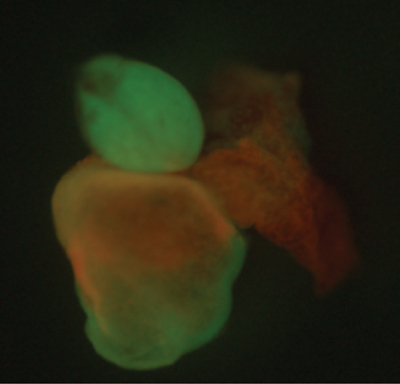
[br]
Description

Our laboratory is interested in understanding the mechanisms that govern the degree of potency of human somatic cells, and how it can be experimentally increased for conditions where doing so may be of biomedical relevance. Specifically, the context in which we investigate these issues is mainly centred on the paradigm of cardiac regeneration/repair. Heart-related diseases are the main cause of mortality in the world, with ischemic heart disease being the single most frequent condition accounting for the death toll. This results from the very limited ability of the mammalian heart to regenerate on its own, and underscores the pressing biomedical need to finding ways for potentiating this ability (heart regeneration) and/or providing new cardiac cells to replace the lost or damaged ones (heart repair). We pursue the first approach by studying the process of heart regeneration in the zebrafish, an organism with a remarkable capacity for regeneration. Natural regeneration is a biologically fascinating phenomenon in which somatic cells may regain developmental potency, and we hope that understanding the molecular and cellular mechanisms that control this process will help devising strategies to potentiate the regeneration of adult mammalian hearts.

For achieving heart repair, in turn, our research is aimed at generating functional human heart muscle cells that could be used for transplantation. For this purpose, we investigate ways to manipulate the developmental potency of human somatic cells so they become pluripotent (i.e. regain the potency of cells in the early embryo), and then study how these so-called induced pluripotent stem cells (iPSC) can be instructed to differentiate into functional cardiomyocytes. In addition, since iPSC can be generated from disease-carrying cells, many laboratories including ours are exploring the possibility of using patient-specific iPSC to generate disease-relevant cell types in which to investigate the pathogenic mechanisms of disease initiation and/or progression. Overall, our research takes advantage of a variety of experimental paradigms (zebrafish heart regeneration, human iPSC generation and differentiation), approached from a multi-disciplinary perspective, ranging from bioengineering approaches to 3D stem cell differentiation to single-cell genetic lineage tracing analyses and genetic manipulation of human cells, aimed at tackling important current issues in biology and biomedicine, such as the mechanisms that control the establishment and maintenance of developmental potency, the initiation and progression of the regenerative process, and the differentiation and functional maturation of human cardiomyocytes, and the development of genuinely human models of human disease. [br]
News/Jobs
IBEC group leader to give public lecture on stem cells
27/10/14
Tomorrow night IBEC group leader and ICREA professor Ángel Raya will give a public lecture at the CCCB in Barcelona entitled «Células madre y medicina regenerativa: realidades y promesas» («Stem cells and regenerative medicine: realities and promises»).
“Izpisúa no s’ha endut cap projecte”
13/02/14
An interview with IBEC group leader Ángel Raya about his new appointment as director of the Centre de Medicina Regenerativa de Barcelona (CMRB) appears in Catalan newspaper Ara today.
“El investigador Ángel Raya destaca el hallazgo de un nuevo modelo basado en células madre para el estudio del párkinson”
29/06/14
Article in Diario Siglo XXI
IBEC group leader to head CMRB
15/01/14
Ángel Raya, ICREA professor and head of IBEC’s Control of Stem Cell Potency group, is to take up up the role of director of Barcelona’s Center of Regenerative Medicine in Barcelona (CMRB).
“1000 Researchers. Five continents. One Day”
14/11/2013
Control of Stem Cell Potency group leader Ángel Raya has been invited to take part in a virtual stem cell meeting today, alongside other experts from all over the world.
Pfizer award for IBEC/Vall d’Hebron collaboration on hemophilia
07/11/2013
A Spanish collaboration, including researchers from IBEC, has been awarded the prestigious ASPIRE Europe 2013 Hemophilia Research Award from Pfizer, the world’s largest research-based pharmaceutical company.
«El laboratori al ‘Connexió’: Institut de Bioenginyeria de Catalunya»
15/07/2013
Control of stem cell potency group leader Ángel Raya appeared on Thursday night’s edition of current events programme Barcelona Connexió on Barcelona Televisió (BTV), in a special report on cloning.
«Creado un hígado a partir de células madre»
04/07/2013
IBEC’s Control of Stem Cell Potency group leader Ángel Raya appears today in La Vanguardia and El Mundo giving his expert opinion on some research published in Nature about a Japanese group that has managed to create a functional human liver using induced pluripotent stem cells.
«Crean embriones humanos con la técnica empleada para clonar a la oveja ‘Dolly’»
27/05/2013
Ángel Raya, group leader of IBEC’s Control of Stem Cell Potency group, gives his expert opinion in several national and local newspapers on last week’s breakthrough in Oregon, where scientists finally managed to derive human embryonic stem cells from adult tissue.
«Un mecanismo biológico podría optimizar el tratamiento del párkinson»
07/03/2013
This week’s press release about Ángel Raya’s Nature Neuroscience paper gained coverage in La Razón, rTVE and many other science and news websites.
Researchers uncover the ‘double-whammy’ that could reveal a promising strategy for Parkinson’s treatments
04/03/2013
An IBEC researcher and his collaborators have revealed an important biological mechanism which could shed new light on how best to develop treatments for Parkinson’s disease.
«Nacen los primeros ratones sanos de ovulos procedentes de celulas madre»
18/10/2012
IBEC group leader Ángel Raya is quoted in articles in online newspapers Público and Materia, giving his expert opinion about some recent research in Japan. The scientists in Kyoto achieved a litter of healthy, fertile mice ‘born’ from undifferentiated stem cells taken from skin.
«Células madre (y padre)»
13/10/2012
El Periódico published an article about Nobel Prize winners John Gurdon and Shinya Yamanaka, who won the prize in medicine or physiology for their achievements in stem cell research. Towards the end of the piece, the author talks about the leading position held by Catalonia in research into stem cells, naming IBEC’s Ángel Raya as one of the region’s pioneers.
A breakthrough in understanding age-related disease
08/03/2012
Researchers at IBEC have made an important leap towards understanding the second most common neurodegenerative illness, Parkinson’s disease (PD), which affects around 5% of the population by age 85.
Lights, camera, action!
14/04/2011
Spanish national TV channel RTVE are paying a visit to IBEC today to interview Ángel Raya, group leader of the Control of Stem Cell Potency group, on the subject of stem cell research for an episode of the science and technology programme ‘Tres14’.
All the fun of the fair
06/04/2011
For the next three days IBEC scientists from the Control of Stem Cell Potency group will be introducing induced pluripotent stem (IPS) cells to the people of Barcelona at the 9th “Live Research” Fair at La Pedrera.
IBEC expands its research program with a new line of stem cell investigation
20/01/2010
The control of stem cell potency is the line of research most recently incorporated into the IBEC program under the leadership of Ángel Raya, a research professor at the Catalan Institute for Research and Advanced Studies (ICREA). This project, which represents an expansion of the institute’s work in the field, now forms part of IBEC’s Cellular Biotechnology research program.
Projects
National projects
| Aproximación de bioingeniería a la regeneración/reparación cardiaca | I+D-Investigación fundamental no orientada | Ángel Raya |
Publications
Equipment
- hES/iPS cell culture station
- Zebrafish transgenesis
- Molecular biology facilities
- Stereomicroscope for picking hES colonies
- Cell culture facilities
Collaborations
- Lorenzo Monserrat Complejo Hospitalario Universitario A Coruña, Spain
- Ana Maria Cuervo Albert Einstein College of Medicine, Bronx, USA
- Ludovic Jullien Ecole Normale Supérieure, Paris, France
- Anne Weber/Anne Dubart Inserm, Le Kremlin-Bicêtre Cedex (France)
- Manuel Galiñanes Hospital Universitari Vall d’Hebron, Barcelona
- Patrizia Dell’Era Università degli Studi di Brescia (Italy)
- Miquel Vila Institut de Recerca, Hospital Universitari Vall d’Hebron, Barcelona (Spain)
- Eduard Tolosa Hospital Clínic, Barcelona (Spain)
- Pedro Muniesa Facultad de Veterinaria, Zaragoza (Spain)
- José López Barneo IBiS, Sevilla (Spain)
- Daniel Grinberg/Lluïsa Vilageliu University of Barcelona (Spain)
- Rafael Garesse Instituto de Investigaciones Biomédicas “Alberto Sols”/UAM (Spain)
- Dra. Antonia Follenzi Universita’ del Piemonte Orientale, Novara (Italy)
- Sheng Ding Scripps Research Institute, La Jolla (USA)
- Jordi Barquinero Institut de Recerca, Hospital Universitari Vall d’Hebron, Barcelona (Spain)
- Jordi Alberch/Josep M. Canals IDIBAPS, University of Barcelona (Spain)
- Antoni Bayés-Genís Hospital de la Santa Creu i Sant Pau, Barcelona
- Jerónimo Blanco & Núria Rubio Centro de Investigación Cardiovascular CSIC-ICCC, Barcelona
- Francisco J. Blanco Complejo Hospitalario Universitario A Coruña
- Juan Bueren CIEMAT, Madrid
- Antonella Consiglio IBUB, Universitat de Barcelona

